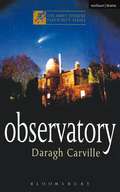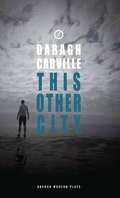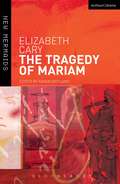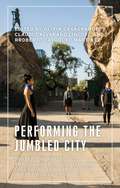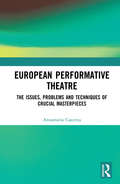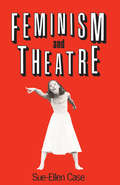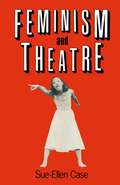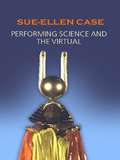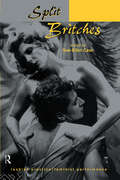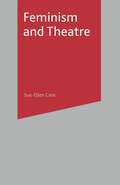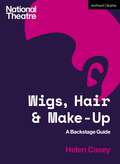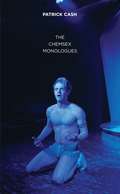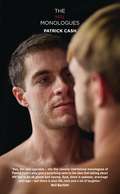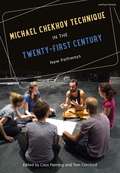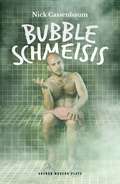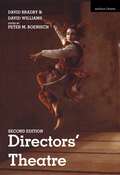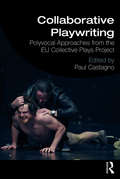- Table View
- List View
Observatory (Modern Plays)
by Daragh CarvilleA gothic science-fiction thriller, Observatory details the entangled lives of four people across two centuriesObservatory is set at the Armagh Observatory and Museum for Astronomy and Natural Philosophy, in both 1799 and 1999. Historian Jon McKenna, hired to compile a computerised catalogue of the Observatory archives, finds his life becoming entangled with that of Nicola McLoughlin, assistant astronomer at the Observatory. Together they work to uncover the two-hundred-year-old story of astronomer Archibald Hamilton and his assistant Robert Hogg - man of science, man of God, and revolutionary. The Observatory, a symbol of both science and religion, becomes the setting for a powerful exploration of nationhood and revolution, love and betrayal."The writing is inspired, deceptively subtle behind its up-front bile and cracked humour" (Guardian)
Observatory (Modern Plays)
by Daragh CarvilleA gothic science-fiction thriller, Observatory details the entangled lives of four people across two centuriesObservatory is set at the Armagh Observatory and Museum for Astronomy and Natural Philosophy, in both 1799 and 1999. Historian Jon McKenna, hired to compile a computerised catalogue of the Observatory archives, finds his life becoming entangled with that of Nicola McLoughlin, assistant astronomer at the Observatory. Together they work to uncover the two-hundred-year-old story of astronomer Archibald Hamilton and his assistant Robert Hogg - man of science, man of God, and revolutionary. The Observatory, a symbol of both science and religion, becomes the setting for a powerful exploration of nationhood and revolution, love and betrayal."The writing is inspired, deceptively subtle behind its up-front bile and cracked humour" (Guardian)
This Other City (Oberon Modern Plays)
by Daragh CarvilleIn the newest play from this prolific Northern Irish writer, Carville turns his attention to the demons beneath the shiny surface of the new, metropolitan Belfast. This Other City plays out against a backdrop of coffee shops, beauty salons and overpriced apartments. It’s a Belfast where dodgy deals are done in boutique hotel rooms with a view.
The Tragedy of Mariam (New Mermaids)
by Elizabeth Cary Karen BritlandThe Tragedy of Mariam, the Fair Queen of Jewry is a Jacobean closet drama by Elizabeth Tanfield Cary. First published in 1613, it was the first work by a woman to be published under her real name. Never performed during Cary's lifetime, and apparently never intended for performance, the Senecan revenge tragedy tells the story of Mariam, the second wife of Herod. The play exposes and explores the themes of sex, divorce, betrayal, murder, and Jewish society under Herod's tyrannous rule. The wide-ranging introduction discusses the play in the context of closet drama, female dramatists and feminist criticism, providing an ideal edition for study and teaching. This is a major edition of an unusual and provocative play not widely available elsewhere.
The Tragedy of Mariam: The Fair Queen Of Jewry (New Mermaids)
by Elizabeth Cary Karen BritlandThe Tragedy of Mariam, the Fair Queen of Jewry is a Jacobean closet drama by Elizabeth Tanfield Cary. First published in 1613, it was the first work by a woman to be published under her real name. Never performed during Cary's lifetime, and apparently never intended for performance, the Senecan revenge tragedy tells the story of Mariam, the second wife of Herod. The play exposes and explores the themes of sex, divorce, betrayal, murder, and Jewish society under Herod's tyrannous rule. The wide-ranging introduction discusses the play in the context of closet drama, female dramatists and feminist criticism, providing an ideal edition for study and teaching. This is a major edition of an unusual and provocative play not widely available elsewhere.
Performing the jumbled city: Subversive aesthetics and anticolonial indigeneity in Santiago de Chile (Anthropology, Creative Practice and Ethnography)
by Olivia CasagrandePerforming the jumbled city is a complex artefact beyond its own materiality. Linked to a dedicated website hosting additional audio-visual materials, the book acts as a connecting device allowing an exchange between texts, audio-visual materials, and original artworks, situating it in the emerging field of multi-modal ethnography. From this stance, and as an edited collection co-authored with urban indigenous artists and activists, it interrogates the ways in which knowledge is built and shared. The book is constructed as a particular kind of edited collection, shifting between different authorships. The resulting interaction between individual and collective essays draws together scholars’ and activists’ perspectives in a rich exchange between textual, visual and dramatic sections, for the book is organised around the original script of the site-specific performance Santiago Waria, and the related exhibition MapsUrbe.Making a claim for creation, rather than recuperation, the essays contained in the book put forward alternative imaginations that disrupt the social and material landscape of the (post)colonial city, defying the spatialities usually assigned to colonised bodies and subjects. As such, and actively engaging with current debates through collective writing by indigenous people raising questions in terms of decolonisation, the book stands as both an academic and a political project, interrogating the relationship between activism and academia, and issues of representation, authorship, and knowledge production.
European Performative Theatre: The issues, problems and techniques of crucial masterpieces
by Annamaria CascettaPerformative theatre is one of the most important trends of our time. It is emblematic of the work of many European theatrical artists in the early twenty-first century. Annamaria Cascetta does not propose a model or a historical overview, but rather strives to identify the salient features of a significant trend in the theatrical research and transformation of our time by analysing some crucial examples from outstanding works, of great international resonance. She draws on work by artists from different generations, all active between the late twentieth century and the first decades of the twenty-first, and in various European countries, performed in a number of European theatres in recent years. The aim is to apply a method of analysis in depth, bringing out the technical elements of contemporary "performative theatre" in the field, and above all to highlight the close links between it and the urgent and troubled issues and problems of history and society in the phase of cultural and anthropological transition we are experiencing.
European Performative Theatre: The issues, problems and techniques of crucial masterpieces
by Annamaria CascettaPerformative theatre is one of the most important trends of our time. It is emblematic of the work of many European theatrical artists in the early twenty-first century. Annamaria Cascetta does not propose a model or a historical overview, but rather strives to identify the salient features of a significant trend in the theatrical research and transformation of our time by analysing some crucial examples from outstanding works, of great international resonance. She draws on work by artists from different generations, all active between the late twentieth century and the first decades of the twenty-first, and in various European countries, performed in a number of European theatres in recent years. The aim is to apply a method of analysis in depth, bringing out the technical elements of contemporary "performative theatre" in the field, and above all to highlight the close links between it and the urgent and troubled issues and problems of history and society in the phase of cultural and anthropological transition we are experiencing.
Feminism and Theatre
by Sue-Ellen CaseThis classic study is both an introduction to, and an overview of, the relationship between feminism and theatre.
Feminism and Theatre
by Sue-Ellen CaseThis classic study is both an introduction to, and an overview of, the relationship between feminism and theatre.
Feminism and Theatre (New Directions in Theatre)
by Sue-Ellen CaseThis study by Sue-Ellen Case serves as both an introduction to and an overview of the relationship between feminism and theatre. It raises questions for the feminist historian who inherits a tradition of theatre history in which women playwrights and actresses are conspicuously absent, and constructs an alternative history of what women have done. In analysing radical feminism and theatre, materialist feminism and theatre, and women of colour, the author explains how political movement has influenced the stage. In examining the development of feminist aesthetics, experiments in organization, performance style and audience. Case simultaneously traces the new role of the female actor, the new position of the spectator, the new form of the play and the new role of the critic. Examples from the United States, Britain, France and Germany are used to illustrate the common ground and the differences between the feminisms and the women in theatre from these countries.
Performing Science and the Virtual
by Sue-Ellen CaseThis impressive new book from Sue-Ellen Case looks at how science has been performed throughout history, tracing a line from nineteenth century alchemy to the twenty-first century virtual avatar. In this bold and wide-ranging book that is written using a crossbreed of styles, we encounter a glance of Edison in his laboratory, enter the soundscape of John Cage and raid tombs with Lara Croft. Case looks at the intersection of science and performance, the academic treatment of classical plays and internet-like bytes on contemporary issues and experiments where the array of performances include: electronic music Sun Ra, the jazz musician the recursive play of tape from Samuel Beckett to Pauline Oliveros Performing Science and the Virtual reviews how well these performances borrow from spiritualist notions of transcendence, as well as the social codes of race, gender and economic exchange. This book will appeal to academics and graduates studying theatre and performance studies, cultural studies and philosophy.
Performing Science and the Virtual
by Sue-Ellen CaseThis impressive new book from Sue-Ellen Case looks at how science has been performed throughout history, tracing a line from nineteenth century alchemy to the twenty-first century virtual avatar. In this bold and wide-ranging book that is written using a crossbreed of styles, we encounter a glance of Edison in his laboratory, enter the soundscape of John Cage and raid tombs with Lara Croft. Case looks at the intersection of science and performance, the academic treatment of classical plays and internet-like bytes on contemporary issues and experiments where the array of performances include: electronic music Sun Ra, the jazz musician the recursive play of tape from Samuel Beckett to Pauline Oliveros Performing Science and the Virtual reviews how well these performances borrow from spiritualist notions of transcendence, as well as the social codes of race, gender and economic exchange. This book will appeal to academics and graduates studying theatre and performance studies, cultural studies and philosophy.
Split Britches: Lesbian Practice/Feminist Performance
by Sue-Ellen CaseThe Split Britches theatre company have led the way in innovative and challenging lesbian performance for the last decade. Split Britches: Lesbian Practice/Feminist Performance is a long awaited celebration of the theatre and writing of Lois Weaver, Peggy Shaw and Deborah Margolin, who make up this outstanding troupe. This unique anthology comes complete with: * seven of Split Britches' best loved performance texts * a critical, historical introduction by Sue-Ellen Case * programme notes to accompany each of the plays * a range of stunning photographic illustrations The publication of the Split Britches play texts, collected here for the first time, provides invaluable access to these celebrated performance pieces for both the student and contemporary arts audience.
Split Britches: Lesbian Practice/Feminist Performance
by Sue-Ellen CaseThe Split Britches theatre company have led the way in innovative and challenging lesbian performance for the last decade. Split Britches: Lesbian Practice/Feminist Performance is a long awaited celebration of the theatre and writing of Lois Weaver, Peggy Shaw and Deborah Margolin, who make up this outstanding troupe. This unique anthology comes complete with: * seven of Split Britches' best loved performance texts * a critical, historical introduction by Sue-Ellen Case * programme notes to accompany each of the plays * a range of stunning photographic illustrations The publication of the Split Britches play texts, collected here for the first time, provides invaluable access to these celebrated performance pieces for both the student and contemporary arts audience.
Feminism and Theatre (New Directions In Theatre Ser.)
by Sue-Ellen Case B. ReynoldsThis classic study is both an introduction to, and an overview of, the relationship between feminism and theatre. The reissued edition features a new Foreword by Elaine Aston who examines the context in which Case's book was written, the influence it has had, subsequent developments in the field and the continued importance of the work.
Feminism and Theatre: Feminist Critical Theory And Theatre (New Directions in Theatre)
by Sue-Ellen Case Bryan ReynoldsThis classic study is both an introduction to, and an overview of, the relationship between feminism and theatre. The reissued edition features a new Foreword by Elaine Aston who examines the context in which Case's book was written, the influence it has had, subsequent developments in the field and the continued importance of the work.
Wigs, Hair and Make-Up: A Backstage Guide (National Theatre Backstage Guides)
by Helen CaseyWritten by the Deputy Head of Make-Up and Wigs at the National Theatre, this book opens up a process that very few people will otherwise be privy to, giving perspectives on the preparation before a production and responsibilities during, as well as looking more widely at training, career opportunities and success. It does so through drawing upon some of the most adventurous and challenging productions mounted at the National Theatre and elsewhere. From designing and fitting wigs to managing lighting-fast quick changes, hair, wigs and make-up people are a major part of the creation of any theatrical production. Yet their role and contribution are much less discussed and written about than elements such as writing, directing and acting, despite being critical to defining and executing the aesthetic of a production. Their involvement requires a great deal of research and creative thinking; collaboration with other members of the creative team; specific knowledge of wig-making and measuring, make-up design and application; and managing all of these elements during the course of the evening. Often required to cover all three elements (and sometimes more), the designer looking after hair, wigs and make-up needs to bring to the production multiple areas of expertise and is a core part of the creative team.
Wigs, Hair and Make-Up: A Backstage Guide (National Theatre Backstage Guides)
by Helen CaseyWritten by the Deputy Head of Make-Up and Wigs at the National Theatre, this book opens up a process that very few people will otherwise be privy to, giving perspectives on the preparation before a production and responsibilities during, as well as looking more widely at training, career opportunities and success. It does so through drawing upon some of the most adventurous and challenging productions mounted at the National Theatre and elsewhere. From designing and fitting wigs to managing lighting-fast quick changes, hair, wigs and make-up people are a major part of the creation of any theatrical production. Yet their role and contribution are much less discussed and written about than elements such as writing, directing and acting, despite being critical to defining and executing the aesthetic of a production. Their involvement requires a great deal of research and creative thinking; collaboration with other members of the creative team; specific knowledge of wig-making and measuring, make-up design and application; and managing all of these elements during the course of the evening. Often required to cover all three elements (and sometimes more), the designer looking after hair, wigs and make-up needs to bring to the production multiple areas of expertise and is a core part of the creative team.
The Chemsex Monologues (Oberon Modern Plays)
by Patrick CashThe Chemsex Monologues explore the sexual, high world of the chillouts through six different characters. A nameless narrator meets a sexy boy on a Vauxhall night out, who introduces him to G’s pleasures; the poster boy for Room Service gets taken to Old Mother Meth’s place by a porn star; Fag Hag Cath is finding the chillouts have become more about the sex; Daniel is a sexual health worker who does community outreach in thesaunas; and the nameless narrator meets up with his sexy boy again in different circumstances. Explicit, funny and touching, The Chemsex Monologues display a realm that is sometimes dark, but populated by very real, loveable human beings.
The HIV Monologues (Oberon Modern Plays)
by Patrick CashHe’s just your type. But hold on. He’s about to tell you he’s got HIV. How will you respond emotionally? Brush it aside and practise safe sex? Go on to a deeper relationship? Or do you walk away? It’s not easy for him either. He’s falling in love with you, by declaring his health status he risks an end to the relationship when it’s hardly begun. In THE HIV MONOLOGUES four characters live and work in a world occupied by the virus which brings danger and stigma. Two of them fall in love: Nick has the virus, Alex doesn’t. But in the shadow of HIV can their new-found relationship survive? In these eloquently interwoven and often funny monologues Patrick Cash invites you to explore these feelings of living with a virus that attacks the emotions as well as the body.
Michael Chekhov Technique in the Twenty-First Century: New Pathways
by Cass Fleming and Tom CornfordThe culmination of an innovative practice research project, Michael Chekhov in the Twenty-First Century: New Pathways draws on historical writings and archival materials to investigate how Chekhov's technique can be used across the disciplines of contemporary performance and applied practice.In contrast to the narrow, actor training-only analysis that dominated 20th-century explorations of the technique, authors Cass Fleming and Tom Cornford, along with contributors Caoimhe McAvinchey, Roanna Mitchell, Daron Oram and Sinéad Rushe, focus on devising, directing and collective creation, dramaturgy and collaborative playwriting, scenography, voice, movement and dance, as well as socially-engaged and therapeutic practices, all of which are at the forefront of international theatre-making.The book collectively offers a thorough and fascinating investigation into new uses of Michael Chekhov's technique, providing practical strategies and principles alongside theoretical discussion.
Bubble Schmeisis (Oberon Modern Plays)
by Nick CassenbaumBubbemeises Noun. Yiddish; a grandmother's story, a tall story, an old wives' tale. Nick Cassenbaum invites you into the warmth of the Canning Town Schvitz, East London’s last authentic bath house. Amongst the steam and ritual Nick will take you on a journey to find the place he belongs. Bubble Schmeisis is full of intimate and personal true stories about identity, home and getting schmeised (washed) by old men.
Directors’ Theatre (Modern Dramatists)
by Edith Cassiers Timmy De Laet Patrice Pavis Duska Radosavljevic Katalin Trencsényi Luk Van DriesThis extended new edition of a seminal text marks the 30th anniversary of the original book's major intervention in the discipline. Bradby and Williams' field-defining book introduced the continental-European approach to directing, recognising the work of the modern stage director as an artist in his or her own right for the first time. Now edited by Peter M. Boenisch in collaboration with David Williams, this new edition includes an additional four chapters by leading contemporary experts on theatre direction. Covering recent practices and developments, as well as new trends in the academic research on directing, Directors' Theatre interrogates working ethics and performance aesthetics, directors' work with actors as a central creative source and their responses to the ongoing reassessment of theatre's role and function in contemporary culture. This long-awaited reissue will make a classic, authoritative study on directors and directing accessible to a new generation of students, scholars and artists. It is essential reading for undergraduate and postgraduate students of Theatre, Performance Studies and Directing.New to this Edition:- Includes four new chapters written by leading contemporary experts on theatre direction: Patrice Pavis, Katalin Trencsényi, the research team of Luk Van den Dries, and DuškaRadosavljevic- New chapters discuss recent approaches and developments in theatre directing as well as research on directing, including artists such as Luk Perceval, Daniel Jeanneteau, Improbable and Ivo van Hove, while also introducing the development of theatre direction in Eastern Europe- The original text has been carefully revised by David Williams and chapters have been supplemented with new introductions and conclusions
Collaborative Playwriting: Polyvocal Approaches from the EU Collective Plays Project
by Paul CastagnoIn Collaborative Playwriting, five collectively written plays apply polyvocal methods in which clash and frisson replace synthesis, a dialogic approach to collective writing that has never before been articulated or documented. Based on the EU Collective Plays Project, this collection of plays showcases each voice in dialogic tension and in relation to the other voices of the text, offering an entirely novel approach to new play development that challenges the single (and privileged) authorial voice. Castagno’s case-study approach provides detailed commentary on each of the various experimental methods, exploring the plays’ processes in detail. The book offers an evolutionary path forward in how to develop new work, thus encouraging and promoting the writing of collective, hybrid plays as having profound benefits for all playwrights. The ground breaking approaches to playmaking in Collaborative Playwriting will appeal to playwriting programs, instructors, academics, professional playwrights, theaters and new play development programs; as well as courses in gender LGBTQ studies, script analysis, dramaturgy and dramatic literature across the theater studies curricula.
